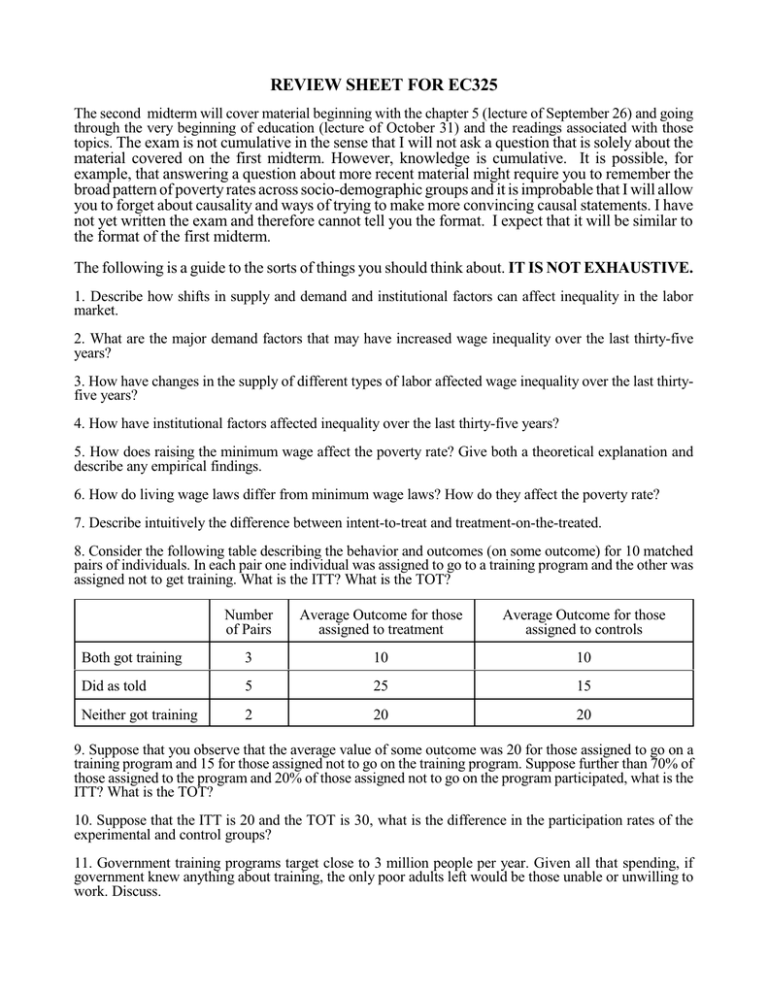REVIEW SHEET FOR EC325
advertisement

REVIEW SHEET FOR EC325 The second midterm will cover material beginning with the chapter 5 (lecture of September 26) and going through the very beginning of education (lecture of October 31) and the readings associated with those topics. The exam is not cumulative in the sense that I will not ask a question that is solely about the material covered on the first midterm. However, knowledge is cumulative. It is possible, for example, that answering a question about more recent material might require you to remember the broad pattern of poverty rates across socio-demographic groups and it is improbable that I will allow you to forget about causality and ways of trying to make more convincing causal statements. I have not yet written the exam and therefore cannot tell you the format. I expect that it will be similar to the format of the first midterm. The following is a guide to the sorts of things you should think about. IT IS NOT EXHAUSTIVE. 1. Describe how shifts in supply and demand and institutional factors can affect inequality in the labor market. 2. What are the major demand factors that may have increased wage inequality over the last thirty-five years? 3. How have changes in the supply of different types of labor affected wage inequality over the last thirtyfive years? 4. How have institutional factors affected inequality over the last thirty-five years? 5. How does raising the minimum wage affect the poverty rate? Give both a theoretical explanation and describe any empirical findings. 6. How do living wage laws differ from minimum wage laws? How do they affect the poverty rate? 7. Describe intuitively the difference between intent-to-treat and treatment-on-the-treated. 8. Consider the following table describing the behavior and outcomes (on some outcome) for 10 matched pairs of individuals. In each pair one individual was assigned to go to a training program and the other was assigned not to get training. What is the ITT? What is the TOT? Number of Pairs Average Outcome for those assigned to treatment Average Outcome for those assigned to controls Both got training 3 10 10 Did as told 5 25 15 Neither got training 2 20 20 9. Suppose that you observe that the average value of some outcome was 20 for those assigned to go on a training program and 15 for those assigned not to go on the training program. Suppose further than 70% of those assigned to the program and 20% of those assigned not to go on the program participated, what is the ITT? What is the TOT? 10. Suppose that the ITT is 20 and the TOT is 30, what is the difference in the participation rates of the experimental and control groups? 11. Government training programs target close to 3 million people per year. Given all that spending, if government knew anything about training, the only poor adults left would be those unable or unwilling to work. Discuss. 12. Describe the principal findings of the JTPA evaluation study. 13. When evaluating job training programs, what are the problems that arise if we compare people who entered training programs with those who did not? What are the problems with comparing people before they entered the program with their performance after they complete it? What are the problems with differences-in-differences (i.e. comparing changes among those who enter a job training program with changes among a fairly similar group of people who do not)? 14. Why might the social and private benefits of job training programs differ? 15. Describe the principal findings of the Job Corps evaluation study based on survey data for the first four years. 16. How did the results from administrative records and survey data differ in the Job Corps evaluation study? How did the results of the ten year follow-up differ from the results of the first four years? 17. What are the principal findings of the nonexperimental evaluation of the Workforce Investment Act? 18. Suppose that a job training program costs more than the (appropriately discounted) amount by which it increases worker earnings over their lifetimes. Why might is nevertheless by better to give training than to give cash transfers? 19. What is meant by "work first?" What are the arguments for and against work first rather than skill-based training programs? What light does the National Evaluation of Welfare to Work Strategies throw on these arguments? Have these results been confirmed in other studies? (note: see the discussion on the reading for 10/1) 20. What has been the U.S. experience with employment tax credits for low-skill workers? What has been the trend since 1940 in the fraction of children born to married women? 21. Describe the trend in the birth rate for: a. Teenagers b. Married women c. Single women 22. How important is each of the follow factors in increasing the fraction of births to unmarried women? a. Increased birth rates among unmarried women b. Reduced birth rates among married women c. Decline in the marriage rate 23. What is the evidence for and against the following views (not all have evidence for): a. Increasing labor market opportunities for women reduced the marriage rate. b. Worsening job opportunities for low-skill men reduced the marriage rate. c. Increasing similarity of job opportunities for men and women reduced the marriage rate. d. The availability of effective contraception and abortion reduced the marriage rate. e. Welfare generosity contributed to increasing the fraction of births that are to unmarried mothers. f. Welfare rules governing payments to one and two parent families reduced the marriage rate. g. Marriage didn’t really decline. Couples were just less likely to marry legally and more likely to cohabit. (Note: This is a question about evidence. A theoretical argument is not evidence.) 24. Why might increased inequality have raised the age at which women marry and thus decreased the marriage rate? 25. Describe the trends in the proportion of births to teens that are illegitimate, the birth rate to unmarried teens and the birth rate to married teens. 26. What is the evidence for and against each of the following views: a. Being a teenage mother leads to worse outcomes for the mother. b. Growing up in a household without both parents leads to worse outcomes as an adult. (Note: This is a question about evidence. A theoretical argument is not evidence.) 27. Does teenage motherhood cause worse outcomes for the children? 28. What is the evidence that WIC improves outcomes for children? 29. What is the evidence that early education and parent education programs improve outcomes for disadvantaged children? 30. How should results reported in “effect size” be interpreted? 31. Does Head Start improve outcomes for disadvantaged children? 32. In the absence of evidence from a random assignment experiment, what are the difficulties involved in evaluating Head Start? 33. Describe the principal early findings of the Head Start Evaluation study. 34. Describe the principal results of the Early Head Start evaluation study. 35. How do the short and long-run effects of Head Start differ? 36. Describe the principal findings from the High Scope/Perry Preschool Project. 37. Do school nutrition programs help poor children? 38. Do mentoring programs help children? 39. Describe the principal findings of the evaluation of the Teen Outreach Program. 40. What are the effects of abstinence programs on teens’ sexual activity and knowledge about the relation between contraceptive methods and STD prevention? 41. Describe the principal findings of the evaluations of the Quantum Opportunities Program. 42. What lessons can we draw from the different findings of the two QOP evaluations and from the CET evaluation? 43. Poor people in high-poverty areas are more likely to commit crimes and less likely to graduate high school or work than people with the same income in low-poverty areas. Why? 44. People often exhibit behaviors similar to those of the people with whom they interact a great deal. Why is this not convincing evidence that they are influenced by the people with whom they interact? 45. What have we learned from the Gautreaux and Moving-to-Opportunity Programs. 46. Does growing up in a housing project worsen outcomes for poor children? 47. What are the principal reasons that education may have a causal effect on earnings? 48. If education is primarily a sorting device and if high-stakes testing raises standards, who is helped and who is hurt by the tests. In addition, you should be able to read a table, explain what the coefficients mean and know whether the parameters are statistically significant. I advise going over the group exercises we did in class.





